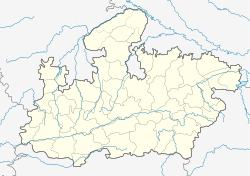Bharhut
| Bharhut | |
|---|---|

East Gateway and Railings, Red Sand Stone, Bharhut Stupa, 2nd Century BCE.
|
|
| Basic information | |
| Location | India |
| Geographic coordinates | 24°26′N 80°52′E / 24.44°N 80.87°ECoordinates: 24°26′N 80°52′E / 24.44°N 80.87°E |
| Affiliation | Buddhism |
| District | Satna |
| State | Madhya Pradesh |
| Region | Vindhya Range |
| Year consecrated | 200-300 B.C. |
| Ecclesiastical or organizational status | Stupa ruins present |
| Status | Artifacts Removed |
Bharhut (Hindi: भरहुत) is a village located in the Satna district of Madhya Pradesh, central India. It is known for its famous relics from a Buddhist stupa. The Bharhut sculptures represent some of the earliest examples of Indian and Buddhist art.
The Bharhut stupa may have been first built by the Maurya king Ashoka in the 3rd century BCE, but many works of art were apparently added during the Shunga period, with many friezes from the 2nd century BCE. An epigraph on the gateway of the stupa mentions its erection "during the supremacy of the Shungas by Vatsiputra Dhanabhuti".
In 1873, Alexander Cunningham visited Bharhut. The next year, he excavated the site. J. D. Beglar, Cunningham's assistant, continued the excavation and recorded the work through numerous photographs.
The complex in Bharhut included a medieval temple (plate II), which contained a colossal figure of the Buddha, along with fragments of sculptures showing the Buddha with images of Brahma, Indra etc. Beglar also photographed a 10th-century Buddhist Sanskrit inscription, about which nothing is now known.
The ruined stupa—nothing but foundations of the main structure (see Gallery)—is still in Bharhut; however, the gateways and railings have been dismantled and reassembled at the Indian Museum, Kolkata. They contain numerous birth stories of the Buddha's previous lives, or Jataka tales. Many of them are in the shape of large, round medallions. Two of the panels are at the Smithsonian.
In conformity with the early aniconic phase of Buddhist art, the Buddha is only represented through symbols, such as the Dharma wheel, the Bodhi tree, an empty seat, footprints, or the triratana symbol.
...
Wikipedia


